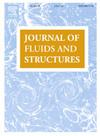Tornado-induced load distribution patterns and structural effects of a super large cooling tower
IF 3.4
2区 工程技术
Q1 ENGINEERING, MECHANICAL
引用次数: 0
Abstract
The investigation was physically and numerically conducted aiming at wind load distribution patterns and structural effects of a super large reinforced concrete cooling tower (SLRCCT) subjected to tornado-like vortices, and the influence of swirl ratios and the central distances between the SLRCCT and the tornado vortex core (TVC) were studied. The tornado-induced loads on the SLRCCT were firstly obtained based on rigid pressure measurement tests. Subsequently, tornado-induced structural displacement and internal force responses were analysed. It is revealed that the swirl ratios and the central distance between the SLRCCT and TVC significantly determine the tornado-induced load distributions and structural performances of the SLRCCT. Finally, an equivalent static wind load mode suitable for tornado resistance design of the SLRCCTs was proposed. Specifically, an empirical polynomial was suggested to fit the critical net wind pressure coefficient envelope. Wind vibration factor based on the evaluation criterion of time-variant dynamic reinforcement ratios was proposed to consider the fluctuating effects of the tornado, and the maximum tangential speed could be used to estimate the intensity influence of the tornado acting on the SLRCCT. This paper aims to contribute to a better understanding of the wind-related effects and the wind-resistant design of the SLRCCTs exposed to disaster-causing non-synoptic winds, particularly tornadoes.
超大型冷却塔龙卷风荷载分布模式及结构效应
针对某大型钢筋混凝土冷却塔(SLRCCT)在类龙卷风涡旋作用下的风荷载分布规律及结构效应进行了物理和数值研究,研究了涡旋比和SLRCCT与龙卷风涡旋核心(TVC)中心距离的影响。首先通过刚性压力测量试验获得了SLRCCT的龙卷风诱导载荷。随后,分析了龙卷风引起的结构位移和内力响应。结果表明,旋涡比和旋涡中心距离对旋涡结构的龙卷风荷载分布和结构性能有显著影响。最后,提出了适用于slrcct抗龙卷风设计的等效静风荷载模式。具体而言,提出了一个经验多项式来拟合临界净风压系数包络。提出了基于时变动力配筋率评价准则的风振因子,考虑了龙卷风的波动效应,并利用最大切向速度来估计龙卷风对SLRCCT的强度影响。本文旨在帮助人们更好地理解在非天气性大风(特别是龙卷风)作用下slrcct的风相关效应和抗风设计。
本文章由计算机程序翻译,如有差异,请以英文原文为准。
求助全文
约1分钟内获得全文
求助全文
来源期刊

Journal of Fluids and Structures
工程技术-工程:机械
CiteScore
6.90
自引率
8.30%
发文量
173
审稿时长
65 days
期刊介绍:
The Journal of Fluids and Structures serves as a focal point and a forum for the exchange of ideas, for the many kinds of specialists and practitioners concerned with fluid–structure interactions and the dynamics of systems related thereto, in any field. One of its aims is to foster the cross–fertilization of ideas, methods and techniques in the various disciplines involved.
The journal publishes papers that present original and significant contributions on all aspects of the mechanical interactions between fluids and solids, regardless of scale.
 求助内容:
求助内容: 应助结果提醒方式:
应助结果提醒方式:


